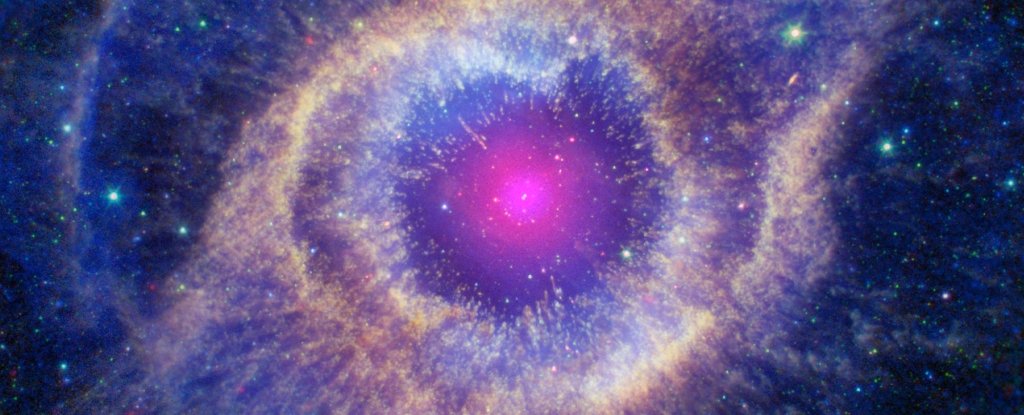Products You May Like
There’s a lot we don’t understand about white dwarf stars, but one mystery may finally have a solution: how do some of these cosmic objects end up having insanely powerful magnetic fields?
According to new calculations and modelling, these super-dense objects can have a magnetosphere-generating dynamo – but the strongest white dwarf magnetic fields, a million times more powerful than Earth’s, only occur within certain contexts.
Not only does the research resolve several long-standing problems, but once again it shows that very similar phenomena can be observed in wildly different astronomical objects, and that sometimes the Universe is more like itself than we might initially think.
White dwarf stars are what we colloquially call “dead” stars. When a star less than around eight times the mass of the Sun reaches the end of its lifespan, having run out of elements suitable for nuclear fusion, it ejects its outer material. The remaining core collapses down into an object less than 1.4 times the mass of the Sun, packed into a sphere around the size of Earth.
The resulting object, shining brightly with residual thermal energy, is a white dwarf, and it’s incredibly dense. Just a single teaspoon of white dwarf material would weigh around 15 tons, which means it would not be unreasonable to assume that the interiors of these objects would be very different from the interiors of planets like Earth.
Astrophysicists have been trying to work out how white dwarf stars can have powerful magnetic fields, in ranges up to around a million times stronger than Earth’s. For context, the Sun’s magnetic field is twice as powerful as Earth’s – so something unusual has to be going on with white dwarfs.
It gets a little tricky, though. Only some white dwarfs have powerful magnetic fields. White dwarfs in detached binaries – in which neither star exceeds the region of space within which stellar material is bound by gravity, known as a Roche lobe – less than a billion years old don’t have these magnetic fields.
But for white dwarfs in semi-detached binaries, where one of the stars spills out of its Roche lobe, and the white dwarf is gravitationally slurping material off its lower-mass companion, more than a third of these exhibit strong magnetic fields. And a few strongly magnetic white dwarfs appear in older detached binaries, too.
Stellar evolution models have been unable to explain how this happens, so an international team of astrophysicists took a different approach, proposing a core dynamo that develops over time, rather than at the time of the white dwarf’s formation.
That dynamo would be a rotating, convecting, and electrically conducting fluid that converts kinetic energy into magnetic energy, spinning a magnetic field out into space. In Earth’s case, convection is generated by liquid iron moving around the core.
“We have known for a long time that there was something missing in our understanding of magnetic fields in white dwarfs, as the statistics derived from the observations simply did not make sense,” said physicist Boris Gänsicke of the University of Warwick in the UK.
“The idea that, at least in some of these stars, the field is generated by a dynamo can solve this paradox.”
When a white dwarf first forms, right after losing its outer envelope, it’s very hot, made up of fluid carbon and oxygen. According to the team’s model, as the core of the white dwarf cools and crystallizes, heat escaping outwards creates convection currents, very similar to the way fluid moves around inside Earth, producing a dynamo.
“As the velocities in the liquid can become much higher in white dwarfs than on Earth, the generated fields are potentially much stronger,” explained physicist Matthias Schreiber of the Federico Santa María Technical University in Chile.
“This dynamo mechanism can explain the occurrence rates of strongly magnetic white dwarfs in many different contexts, and especially those of white dwarfs in binary stars.”
As the white dwarf cools and ages, its orbit with its binary companion grows closer. When the companion exceeds its Roche lobe, and the white dwarf begins accreting material, the spin rate of the white dwarf increases; this faster rotation also affects the dynamo, producing an even stronger magnetic field.
If this magnetic field is strong enough to connect with the magnetic field of the binary companion, the binary companion exerts a torque that causes its orbital motion to synchronize with the white dwarf’s spin, which in turn causes the binary companion to detach from its Roche lobe, returning the system to a detached binary. This process will eventually repeat.
A different mechanism will probably be required to explain the very strongest white dwarf magnetic field strengths, but for now, the team’s results are consistent with observations. White dwarfs in detached binaries are older than a billion years, and have previously experienced mass transfer in a semi-detached stage cut short when a wild magnetic field appeared.
If the team’s model is accurate, future white dwarf observations will continue to be consistent with their findings.
“The beauty of our idea is that the mechanism of magnetic field generation is the same as in planets,” Schreiber said.
“This research explains how magnetic fields are generated in white dwarfs and why these magnetic fields are much stronger than those on Earth. I think it is a good example of how an interdisciplinary team can solve problems that specialists in only one area would have had difficulty with.”
The research has been published in Nature Astronomy.
